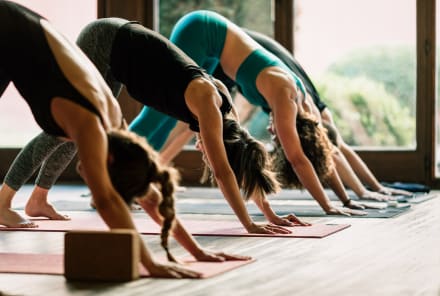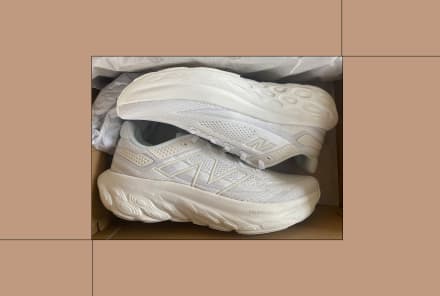Advertisement
This Mistake Can Get In The Way Of Your Weightlifting Progress


As a personal trainer, I've seen a lot of extremes. From the gym rat who lifted weights every day to gain muscle faster to the newbie who worked out seven days a week without following a consistent program. What did they all have in common? Plateaus, injuries, and frustration.
Here's the thing: In order to see real progress from resistance training, you need to give your body time to recover. After all, when you lift weights, you are actually tearing your muscles—and overdoing it can be detrimental to your progress. Here's a trainer-approved primer on why rest is so important and how long you should be taking between your strength sessions.
The importance of leaving time between strength training sessions
During a weight training session, your muscles undergo a series of changes. "When we weight train, we're tipping the first domino toward increasing muscle size, strength, and/or performance," says Josh Honore, NASM, CPT, and coach for Row House.
Initially, your body will use stored glycogen for energy, and as this gets depleted, it will start to break down fat and protein for energy, depleting your muscles' energy reserves and breaking down muscle fibers. As a result of this process, muscle fibers can tear and fluids can be lost, which can cause soreness and inflammation. In response to these tears, muscles send a signal that they are injured, and specific cells that grow and regenerate muscle cells respond.
"The actual adaptation happens at rest," explains Honore. "If you don't give the body enough time between workouts, your adaptation process gets cut short. You leave valuable gains on the table and can enter your next workout without being fully recovered," adds Honore.
Rest is equally important for our mental health. Many of us turn to exercise as a stress reliever, but overtraining can lead to burnout1, stress, and anxiety. When you weight train, you're raising your heart rate and increasing the cortisol in your body. The problem is, when you are going through a stressful time in life and adding a rigid weightlifting schedule on top of that, you may do more damage than good.
Instead of thinking of exercise as a "chore," think of it as something you get to enjoy. The key to a healthy lifestyle is to make exercise enjoyable and rewarding rather than a source of tension or stress.
How much time should you leave between workouts?
Generally, you should listen to your body when it comes to deciding whether you're recovered enough for your next lifting session. But if you're new to weightlifting, there are some guidelines.
"Allow at least 24 up to 72 hours of rest between training the same muscle group," says Alex Stone, DPT, NSCA. "Larger muscle groups may require more recovery time, while smaller muscle groups might recover more quickly," Stone adds. For example, your glutes, the largest muscle group in the body, can handle a higher level of stress better than smaller muscle groups like your arms but can take longer to recover as a result.
Research from the ACE Scientific Advisory panel says that it could take from two days up to a week for individuals to recover depending on the intensity of their session and other factors such as age, the quality of recovery (more on that later), and the type of body part being trained.
In terms of how often you should train a large body part like your legs or glutes, the short answer is two to five days per week. A study on young, trained men showed that the optimal number of sets for muscle building2 was 12 to 20 sets a week. According to research, females adapt similarly to resistance training3 for building muscle, so the same range of sets should be performed. If you're regularly going to the gym and completing five sets of five different exercises per leg day, then you might only need about one high-intensity leg session a week to fully reap the benefits.
Meanwhile, if you run a tight schedule and you prefer to do only three exercises at two sets each, you might benefit from three to four leg sessions per week. There is no one right way to weight train—knowing your body and your limits is one part of the equation. Thus, a solid weightlifting program involves finding out what works best for your lifestyle and following it.
Summary
Post-workout recovery tips for muscle building
It's not just how long you rest between sessions that matters—the quality of your rest is important too. Here are some tips to help your body fully recover after a tough session.
Nutrition: If rest is the first step in getting the most out of your weight training sessions, nutrition is the second. In fact, sufficient protein intake and resistance training are the two main components of muscle growth4. After a workout, your body goes into a process called muscle protein synthesis (MPS), in which protein is used to repair damaged muscle fibers and increase muscle strength and mass. This is why it's important to consume a sufficient amount of protein during the day to provide the necessary building blocks for muscle repair. Proteins from both animals and plants, along with plenty of macronutrients and micronutrients, form the basis of a balanced diet.
RELATED READ: What To Eat After A Workout To Build Muscle
Supplements: Supplements can give active people an extra boost. For example, many people struggle to get enough protein through food when building muscle mass, so adding a supplement can make a big difference. While the benefits of whey protein for muscle-building are well known, some studies have shown collagen can also support muscle growth5, along with its other benefits. If you're looking for something that will improve your physical well-being, consider ingredients like ashwagandha or turmeric, which have both been shown to reduce inflammation and joint pain6 from exercise. Here are nine of the best supplements for supporting joint health and mobility and combating inflammation, according to a nutrition Ph.D. Always consult a health professional before adding a new supplement to your routine.
Sleep: Sleep is often overlooked as a key component of recovery, but it plays a crucial role in repairing and rebuilding your body7 after exercise. "Aim for at least seven to nine hours of sleep per night to support optimal muscle growth and recovery," says Stone. You produce growth hormone (GH) when you sleep, so if you don't get enough sleep continually, your GH will be suppressed. By getting enough sleep, you allow your body's hormones to perform their functions and repair muscle tissue.
Active recovery: Everyone defines "rest days" differently, but they never mean lying around on the couch all day. Active recovery involves low-intensity exercise that focuses on increasing blood flow to the muscles without causing additional stress or damage. This can include activities such as walking your dog, biking with your friends, or low-impact swimming. "By engaging in these types of activities, you can help to reduce muscle soreness, promote blood circulation, and help flush out metabolic waste products from the muscles, aiding in recovery," says Stone.
The takeaway
While it may seem counterintuitive, rest actually helps you make progress. Without sufficient rest, your body will struggle to repair itself, hindering your progress, or worse, leading to injury. Taking care of your body requires you to learn to listen to it, too. If you feel burnt out and only managed to get four hours of sleep the night before, perhaps it's time to take a day off. Remember, the journey to achieving your fitness goals is not a sprint, it's a marathon, as well as a lifetime investment in your health.
7 Sources
- https://www.ncbi.nlm.nih.gov/pmc/articles/PMC8230380/
- https://pubmed.ncbi.nlm.nih.gov/35291645/#:~:text=According%20to%20the%20results%20of%20this%20review%2C%20a%20range%20of,hypertrophy%20in%20young%2C%20trained%20men.
- https://pubmed.ncbi.nlm.nih.gov/32218059/
- https://www.mdpi.com/2072-6643/10/2/180
- https://www.ncbi.nlm.nih.gov/pmc/articles/PMC6566884/
- https://pubmed.ncbi.nlm.nih.gov/32749918/
- https://www.ncbi.nlm.nih.gov/pmc/articles/PMC7785053/#:~:text=4.1.-,Acute%20sleep%20deprivation%20decreases%20muscle%20protein%20synthesis,population%20of%20healthy%20young%20adults.
Watch Next
Enjoy some of our favorite clips from classes
Enjoy some of our favorite clips from classes
What Is Meditation?
Mindfulness/Spirituality | Light Watkins
Box Breathing
Mindfulness/Spirituality | Gwen Dittmar
What Breathwork Can Address
Mindfulness/Spirituality | Gwen Dittmar
The 8 Limbs of Yoga - What is Asana?
Yoga | Caley Alyssa
Two Standing Postures to Open Up Tight Hips
Yoga | Caley Alyssa
How Plants Can Optimize Athletic Performance
Nutrition | Rich Roll
What to Eat Before a Workout
Nutrition | Rich Roll
How Ayurveda Helps Us Navigate Modern Life
Nutrition | Sahara Rose
Messages About Love & Relationships
Love & Relationships | Esther Perel
Love Languages
Love & Relationships | Esther Perel

















